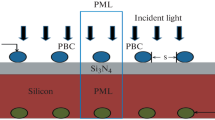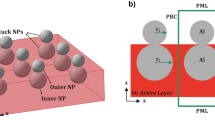Abstract
For Si thin-film solar cells to become efficient, schemes to increase the optical absorption in the films are necessary. Scattering of light using plasmonic resonances in metal nanoparticles has been suggested as a feasible route. When placed on a dielectric layer on the front of a solar cell, such metal nanoparticles can scatter a large fraction of the incident light into the solar cell at the resonance wavelength, and hence increase the light collection. However, many related effects may lead to a reduction in photocurrent. Thus, nanoparticle plasmon resonances must be optimized in order to improve the overall light collection. From an experimentalist’s point of view, simple and fast experimental design tools should be explored. In this work, we investigate the plasmon-related photocurrent enhancements for Si test-solar cells with a number of different metal nanoparticle shapes and materials placed on top of a dielectric layer. The spectral position of the photocurrent-enhancement onset is compared to plasmon resonance calculations based on a fairly simple model. Despite the fact that the optical interactions in nanoparticle solar cell configurations can be quite complex, the photocurrent enhancement in the investigated test-solar cells can be predicted qualitatively well for particles with a plasmon resonance in the visible spectrum. This simple and fast model can be used as a rule of thumb in designing nanoparticle arrays for a specific photocurrent enhancement profile.






Similar content being viewed by others
Notes
Due to practical circumstances the reflectance of the Al_1 sample was measured using a Perkin Elmer Lambda 1050 high-performance spectrometer also with an integrating sphere, using a Spectralon white standard as the reflectance reference.
References
Atwater HA, Polman A (2010) Plasmonics for improved photovoltaic devices. Nat Mater 9:205
Beck FJ, Mokkapati S, Catchpole KR (2011) Light trapping with plasmonic particles: beyond the dipole model. Opt Express 19:25230
Spinelli P, Hebbink M, de Waele R, Black L, Lenzmann F, Polman A (2011) Optical impedance matching using coupled plasmonic nanoparticle arrays. Nano Lett 11:1760–1765
Catchpole KR, Polman A (2008) Design principles for particle plasmon enhanced solar cells. Appl Phys Lett 93:191113
Villesen TF, Uhrenfeldt C, Johansen B, Lundsgaard HJ, Ulriksen HU, Nylandsted Larsen A (2012) Aluminum nanoparticles for plasmon-improved coupling of light into silicon. Nanotechnology 23:085202
Lim SH, Mar W, Matheu P, Derkacs D, Yu ET (2007) Photocurrent spectroscopy of optical absorption enhancement in silicon photodiodes via scattering from surface plasmon polaritons in gold nanoparticles. J Appl Phys 101:104309
Hägglund C, Zäch M, Petersson G, Kasemo B (2008) Electromagnetic coupling of light into a silicon solar cell by nanodisk plasmons. Appl Phys Lett 92:053110
Johansen B, Uhrenfeldt C, Pedersen TG, Ulriksen HU, Kristensen PK, Jung J, Søndergaard T, Pedersen K, Nylandsted Larsen A (2011) Optical transmission through two-dimensional arrays of β-Sn nanoparticles. Phys Rev B 84:113405
Mokkapati S, Beck FJ, Polman A, Catchpole KR (2009) Designing periodic arrays of metal nanoparticles for light-trapping applications in solar cells. Appl Phys Lett 95:053115
Kelly KL, Coronado E, Zhao LL, Schatz GC (2003) The optical properties of metal nanoparticles: the influence of size, shape, and dielectric environment. J Phys Chem B 107:668–677
Simsek E (2009) On the surface plasmon resonance modes of metal nanoparticle chains and arrays. Plasmonics 4:223
Zorić I, Zäch M, Kasemo B, Langhammer C (2011) Gold, platinum, and aluminum nanodisk plasmons: material independence, subradiance, and damping mechanisms. ACS Nano 5:2535–2546
Uhrenfeldt C., Lundsgaard Hansen J., Villesen T. F., Jung J., Ulriksen H. U., Garm Pedersen T., Pedersen K., Nylandsted Larsen A. (2010) Effects of disc shape on plasmon enhanced optical absorption in solar cells. Proc. 25th EU PVSE 637–640
Bohren CF, Huffman DR (1983) Absorption and scattering of light by small particles. Wiley Interscience, New York
Klein MV, Furtak TE (1986) Optics, 2nd edn. Wiley, New York
Acknowledgments
The authors greatly acknowledge the financial support from the project “Localized surfcae plasmons and silicon thin-film solar cells-PLATOS” financed by the Villum Foundation.
Author information
Authors and Affiliations
Corresponding author
Rights and permissions
About this article
Cite this article
Uhrenfeldt, C., Villesen, T.F., Johansen, B. et al. Tuning Plasmon Resonances for Light Coupling into Silicon: a “Rule of Thumb” for Experimental Design. Plasmonics 8, 79–84 (2013). https://doi.org/10.1007/s11468-012-9424-7
Received:
Accepted:
Published:
Issue Date:
DOI: https://doi.org/10.1007/s11468-012-9424-7




